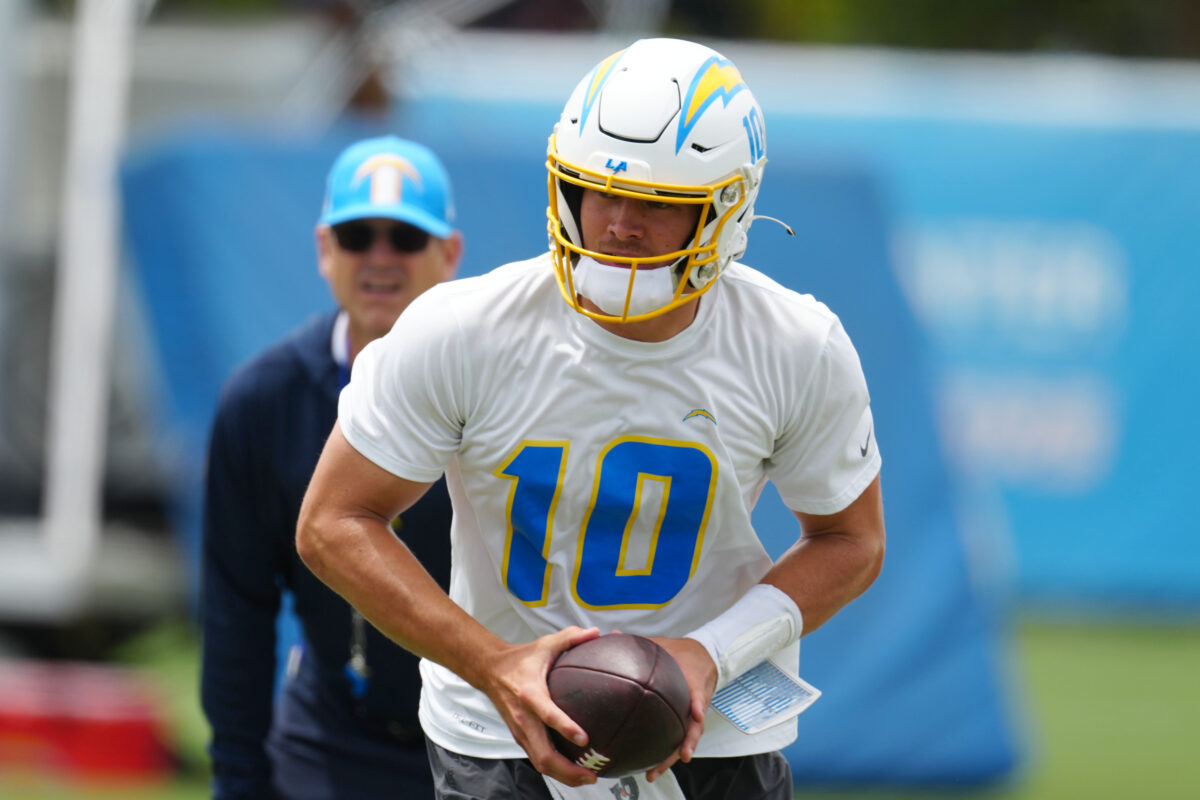Justin Herbert has been trapped in purgatory.
It’s been more than three years since the Los Angeles Chargers’ hopeless training staff thrust him head-first into a rookie of the year campaign by puncturing Tyrod Taylor’s lung. That season, a draft pick who looked like more potential than production was a revelation. Herbert threw for nearly 290 yards per game. His 98.3 passer rating was nearly 10 points higher than Joe Burrow, the quarterback selected five spots ahead of him atop the 2020 NFL Draft.
This set up Herbert as the league’s next great young franchise quarterback. But Los Angeles has been unable to move forward from there. Three seasons with human broken Magic 8-Ball Brandon Staley at head coach and a never-quite-trustworthy offensive line curtailed Herbert’s downfield game, leaving him to easily slide under a high bar of expectations in both 2022 and 2023.
That led to Staley’s ouster this winter. In his place is a head coach who has repeatedly proven capable of driving his quarterbacks to new heights.
Jim Harbaugh guided Michigan to its first NCAA title since 1997 last winter. Along the way, he made JJ McCarthy one of the FBS’s most efficient quarterbacks. Before that, he pushed Colin Kaepernick from Alex Smith’s understudy to Super Bowl quarterback. Go even further and you’ll find him molding Josh Johnson into a 15-year pro football veteran despite cutting his teeth at non-scholarship FCS program San Diego.
That’s how a throwback, establish-the-run coach is so vital for a 26-year-old passer who went from ranking fifth in the NFL in expected points added (EPA) per dropback in 2021:

to 16th over the last two seasons:

How will Harbaugh get this done? Let’s look at his past to determine Los Angeles’ future. And let’s start with the obvious. Harbaugh is going to establish the run, no matter which direction the winds of offensive trends may be blowing.
Jim Harbaugh’s offenses are exactly as run-heavy as you thought
Since 2007, he’s been the head coach of either an NFL or Power 5 college football program. In those 17 years, he’s passed the ball more than he’s run it exactly twice — and one of those was the pandemic-shortened 2020 season, so it barely counts.

Harbaugh’s teams won a lot, so that skews the results toward a clock-killing offense. But in great times or merely moderately good ones, his playbook leaned heavily on grinding runs to create opportunities for the pass.
It’s not like he was planning around bad quarterbacks in the process. Andrew Luck quarterbacked two of those Stanford seasons (2009 and 2010). JJ McCarthy was a 2024 first round draft pick. Jake Rudock, John O’Korn and Wilton Speight… well, OK, they weren’t all winners. But for the most part, Harbaugh’s offenses maintained a similar run-heavy ethos regardless of who was slinging the ball.
Now he gets Herbert, who could badly use some support in the midst of significant roster turnover. The Chargers offense will look very different in 2024 even before Harbaugh’s influence.
Keenan Allen is a Chicago Bear, Mike Williams is a New York Jet and Austin Ekeler is a Washington Commander. Los Angeles’ top three wideouts could be Josh Palmer, Quentin Johnston and Ladd McConkey, flanked by JK Dobbins at tailback and Hayden Hurst at tight end. Even if all those guys exceed expectations, that’s a pretty big shift from the lineup Herbert played with the first four years of his pro career.
Creating the foundation of a run-heavy offense won’t be easy either. Joe Alt is an impressive specimen who can pair with Rashawn Slater to give LA one of the best tackle combinations in the league. Things aren’t as stable on the interior, where Zion Johnson has failed to live up to his first round pedigree, Jamaree Salyer has played roughly up to his sixth round status in two seasons and Bradley Bozeman is stable but not special.
Then you get to the running back rotation, which is relying on a lot of best case scenarios. Dobbins has only 100 carries since 2020 and is coming off a torn Achilles. Gus Edwards is 29 years old and coming off his least efficient season as a pro. Kimani Vidal was a thoroughbred at Troy but is also a Day 3 rookie draft pick facing a steep jump in competition. This may not be the stable needed to create the third-and-short situations that have made life easier for so many Harbaugh offenses.
You know what? That’s fine.
The Chargers don’t have to compete in 2024 to feel good about their choices
Los Angeles walked through salary cap hell in gasoline boots this offseason, losing recognizable stars in the process. The offense will have to rebuild, but the most important pieces — sans a proven wideout — are there. Quarterback and both tackle positions are extremely solid.
The defense managed to keep both Joey Bosa and Khalil Mack around, which would be more encouraging if that unit weren’t below average in most regards last season. There aren’t any major additions on that side of the ball — the Chargers’ defensive rookies all came in the third round or later — which suggests LA will have to counterpunch its way through slugfests in order to exceed expectations in 2024.
That’s unlikely, but it doesn’t mean this team is cooked. 2024 is about setting up chess pieces and proving the Harbaugh we last saw guiding the 49ers to prominence is still there. Losing stinks, but it also helps stock the cupboard for a coach who has proven himself as an upper class talent developer no matter where he’s been.
Herbert’s stats will once again paint him as an average quarterback rather than a franchise savior. But, if all goes well, anyone watching the games will be able to see this team’s potential shine through the muck.
